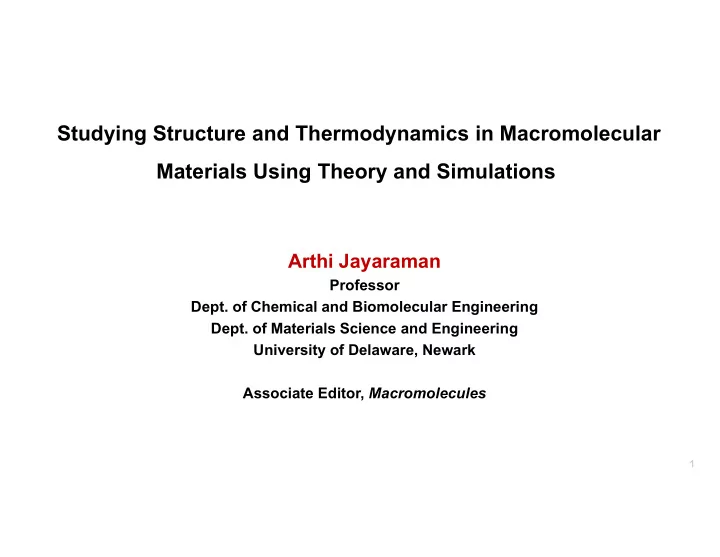

Studying Structure and Thermodynamics in Macromolecular Materials Using Theory and Simulations Arthi Jayaraman Professor Dept. of Chemical and Biomolecular Engineering Dept. of Materials Science and Engineering University of Delaware, Newark Associate Editor, Macromolecules 1
Research Thrusts and Interests in the Jayaraman Lab Linking molecular features to macroscopic morphology and thermodynamics Past and current Functionalized nanoparticles in Solvent role in assembly of colloids & projects funded by polymers polymer nanocomposites Nucleic acids based materials Peptide-polymer based biomaterials 25 Å ⁞ ⁞ ELP 10 Å 5 Å CLP Self-assembled monolayer (SAM) 2
Development of Development of coarse-grained coarse-grained models models Molecular Molecular Polymer Reference Polymer Reference simulations simulations Interaction Site Interaction Site (stochastic & (stochastic & Model (PRISM) Model (PRISM) deterministic) deterministic) theory theory Experiments from our collaborators 3
I. Assembly of amphiphilic non-linear polymers in solution: Theory-simulation (my group) & experiment (collaborators) 4
Validation of Coarse-grained Model Simulation – Effects of Varying Architecture Computational Reverse Engineering from Theory – Simulation Link Scattering Data 5
Coil-brush amphiphilic copolymers Synthesis by Ms. Mei Dong & Prof. Karen L. Wooley at Texas A&M Characterization by Ms. Jee Young Lee & Prof. Darrin Pochan at Univ. of Delaware Simulations by Mr. Michiel Wessels & Prof. Arthi Jayaraman at Univ. of Delaware M. Dong, M. Wessels, J. Young Lee,…, D. Pochan, A. Jayaraman, K. Wooley ACS Nano (2019), 13, 5147-5162 6
Phase Diagram - Experiments vs. Simulations Experiments Simulations The coarse-grained model and simulation approach is appropriate to capture the regions of micelle structures seen in phase diagram from experiments as a function of the design parameters relevant to branched amphiphiles M. Dong, M. Wessels, J. Young Lee,…, D. Pochan, A. Jayaraman, K. Wooley ACS Nano (2019) 13, 5147-5162 7
Exploration of varying non-linear polymer architectures, sequence and composition using theory and simulations 9 polymer architectures 3 sequences: AB, ABA, and BAB 3 compositions: A:B 50:50, A:B 25:75, and A:B 75:25 M. Wessels, A. Jayaraman*, Self-assembly of amphiphilic polymers of varying architectures near attractive surfaces, Soft Matter (2020) 16, 623-633 M. Wessels, A. Jayaraman*, Molecular dynamics simulation study of linear, bottlebrush, and star-like amphiphilic block polymer assembly in 8 solution, Soft Matter , (2019) 15, 3987-3998
Combining PRISM theory and MD simulations PRISM theory can be used to explore a wide design space of polymer architectures to predict phase transitions and guide use of MD simulations only for the exciting design parameters LINEAR COPOLYMERS I. Lyubimov, M. Wessels, A. Jayaraman, Macromolecules, 2018, 51 (19), 7586 BOTTLEBRUSH COPOLYMERS I. Lyubimov, D. J. Beltran-Villegas, A. Jayaraman, Macromolecules, 2017, 50, 7419
pyPRISM: An Open Source Package for PRISM Theory github.com/usnistgov/pyPRISM pyPRISM.readthedocs.io pyPRISM Tool Article pyPRISM is an open source package for PRISM theory that predicts the structure and T. B. Martin, T. Gartner, R. Jones, C. Synder, A. thermodynamics of polymer blends, solutions Jayaraman, Macromolecules 51 (8), 2906 and nanocomposites (2018) n Soft PRISM Theory Article K. S. Schweizer, J. Curro, Phys. Rev. Lett., 58 (3) 246 (1987 ) Dr. Tyler Martin Mr. Thomas Gartner Dr. Ron Jones Prof. Arthi Jayaraman . . Dr. Chad Snyder 10
Using genetic algorithm and simulations to interpret scattering profiles of the micelles in amphiphilic polymer solutions Computational Reverse-Engineering Analysis for Scattering Experiments on Amphiphilic Block Polymer Solutions Daniel J. Beltran-Villegas, Michiel G. Wessels, Jee Young Lee, Yue Song, Karen L. Wooley, Darrin J. Pochan, and Arthi Jayaraman JACS (2019) 141 (37), 14916-14930
PRISM theory and MD simulations for polymer nanocomposites 12
Simulations of macromolecular materials with directional interactions Proteins DNA Image from https://www.molbiolcell.org/ Image from http://book.bionumbers.org/ Polymers Nanocomposites Polymers with Multiple with H ‐ bonding Chemistries Hydrogen ‐ Bonded End Groups Heo, K., Miesch, C., Emrick, T. & Hayward, R. C.. Nano Letters 13 , 5297–5302 (2013). Feldman, Kade, de Greef, Meijer, Kramer and Hawker Macromolecules, 41, 4694 ‐ 4700, (2008) 13
New coarse ‐ grained models for macromolecules with directional interactions Polysaccharides Starting from our previous DNA models … … we have now built CG models for polymers with directional interactions enabling studies of a broad range of polymeric materials D. J. Beltran ‐ Villegas, D. Intriago, K. Kim, N. Behaptu, J. D. Londono, A. Jayaraman*, Coarse ‐ grained molecular dynamics simulations of α‐ 1,3 ‐ glucan, Soft Matter , (2019) 15, 4669 ‐ 4681 Collagen like polypeptides (CLPs) Polymer Nanocomposites (PNCs) A. Kulshreshtha and A. Jayaraman, Impact of Hydrogen J.E. Condon and A. Jayaraman, Development of Coarse ‐ Grained Bonding Interactions on Graft–Matrix Wetting and Structure in Model of Collagen ‐ like Peptide (CLP) for Studies of CLP Triple Polymer Nanocomposites, Macromolecules (2019) 52 (7), Helix Melting " J. Phys. Chem B (2018) 122 1929–1939 2725 ‐ 2735 14
Recommend
More recommend